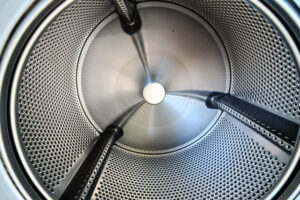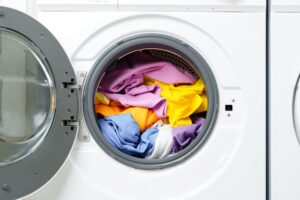Modern households have made life so much easier with the advent of the washing machine, a core helper in doing chores efficiently and quickly. Like any other appliance, they will also be subject to wear and tear over time. Understanding common problems that may arise and how to repair them can save you time and money, not to mention the hassle of dealing with a repair service.
Here, we take you through the top washing machine problems and provide you with easy, step-by-step solutions on how to fix washing machine by yourself.
Top Washing Machine Problems
1. Washing Machine Not Spinning
Some of the most common issues users have with this appliance are when their washing machine will not spin. Here are the potential causes and DIY washing machine repair solutions:

Causes:
Overloading: Stuffing the machine to its full capacity, often results in the improper spinning of the washing machine. The heavyweight inside the drum makes its rotation act hard, and the machine stops in its operation, which may cause damage.
Unbalanced load: There is the effect of uneven distribution of clothes inside the drum that can make the machine unbalanced. The imbalance in turn triggers the machine to stop the cycle from spinning for further protection against damage.
Faulty lid switch: The lid switch is a safety feature that prevents the washer from spinning when it is open. This is another common scenario wherein, if faulty, the machine may not spin even when the lid is closed.
Worn-out drive belt: The drive belt is connected to the motor and drum, and therefore delivers power so that the latter rotates. However, if it becomes worn out or broken, the tumbling of the drum cannot rotate, and thus the machine would not spin.
Solutions:
Load the washing machine correctly: Never overload the machine. Follow the manufacturer’s instructions regarding the maximum load limit and ensure that clothes are evenly distributed inside the drum for any particular cycle. This helps not to overload while keeping the balance in the cycle of spinning.
Balance loads-check to readjust: For a washing machine making noise, shaking, or refusing to spin, pause the cycle and redistribute the clothes inside. Make sure towels and other heavy items are distributed evenly or divided to avoid imbalance.
Inspect and replace the lid switch: If the machine doesn’t spin when the lid is closed, the lid switch may be faulty. Consult the machine’s manual for instructions on how to access the switch. If needed, replace the switch to restore spinning functionality.
Replace drive belt: If the drive belt is worn or snapped, then this will have to be replaced. This can be rather messy, so please refer to the operating handbook for your particular washing machine or consider calling in a professional if you do not feel confident.
2. Washing Machine Leaking Water
A very common problem is water leakage which creates a lot of mess in the laundry room and leads to possible water damage. To fix the problem, its source must be identified.

Causes:
Damaged Hoses: They involve the main performance of the washing machine, which fills the water and drains it through the use of hoses. Over time, these may crack, break, or eventually loosen, causing leakages.
Faulty seal of the doors: Gasket seals around the doors prevent the water from leaking out of the machine during the wash. If it is worn out damaged, or dirty, it will leak.
Clogged drain pump: The drain pump is responsible for clearing off the water from the machine after a cycle. In cases of blockage of the pump, water finds it difficult to get out and hence overflows.
Solutions:
Replace the hose for any damage: This involves checking all hoses from time to time for any signs of wear. Any time you notice any crack or leak, replace it with a new one immediately. Ensure all the connections are secure to avoid any leakages.
Seal the door: Check the seal on the door for dirt, mold, or damage. Clean with a mild detergent and a soft cloth. If damaged, replacement would be best to avoid leakage in the future.
Check and clean the drain pump: Scrape off any blockage from the drain pump according to the instructions in your washing machine’s manual. Regular cleaning of the pump will prevent blockages; thus, water can drain appropriately.
3. Noisy Washing Machine
Odd noises from your washer can be a bit distressing. More often than not, strange sounds coming from it are symptoms of problems that should be attended to before they become major issues.

Causes:
Foreign objects in the drum: Sometimes, coins or buttons-and even smaller objects that have been left in pockets-fall inside the drum and lead to rattling or banging during a wash cycle.
Bad drum bearings: These are the bearings on which the drum rotates. In some time, these bearings may wear out and make the machine noisy during operation; this noise can best be described as a grinding, rumbling sound.
Loose drum: A drum that is not fixed may tend to knock or bang as a result of the movement from the wash and spin cycles.
Solutions:
Foreign object pickups from the drum: Always check for and clear your pockets before putting clothes in the washer. In case of a rattling sound, stop the machine and check for any foreign object in the drum.
Check and replace drum bearings: If the noise is still there and you suspect that it may be because the bearings are worn out, you should either refer to your machine’s manual or call in a professional. Replacing drum bearings can be a tricky task.
Tighten the drum: In case, if the washer’s drum is loose, then you may have to fasten it with its bolts or screws. You may get help from the manual of your washing machine or an expert for this.
4. Washing Machine Not Draining
A washing machine that does not drain appropriately will leave your clothes soggy and might even cause water to spill out of the machine.

Causes:
Clogged drain hose: The water inside the machine is fetched and moved away by the drain hose, therefore allowing room for more water inside the machine. After a few uses, the inner part of the hose tends to block because of the debris it catches.
Defective drain pump: If the drain pump is defective, it won’t be able to pump out any water, hence leaving your machine full of water at the end of the cycle.
Clogged filters: Most washing machines are equipped with filters that catch lint and other residues. If these filters become clogged, they can prevent water from draining.
Solutions:
Drain hose cleaning: First, unclamp and remove the drain hose, then check for blockages. With a long, flexible brush, clean the inside of the drain hose to eliminate congestion. Make sure that the hose is properly reconnected-no kinks or sharp bends-which can hamper the easy flow of water.
Drain Pump Inspection and Replacement: If the drain pump is defective, it should be replaced. Refer to your machine’s manual for instructions on how to access the pump or consider hiring an expert in this type of repair.
Cleaning or replacement of filters: It will be necessary to regularly check the filters for blockages and clean them. In cases where these filters are damaged or heavily clogged, replacing them will be necessary to ensure proper drainage.
5. Washing Machine Not Starting
A non-starting washing machine can be quite a nuisance when there is a waiting load of laundry. This might start from several causes, from simple power supply up to complex internal faults.

Causes:
Power supply problems: The machine would not turn on if it does not get any power. It may be because of a tripped circuit breaker, a faulty power cord, or an unplugged machine.
Faulty door latch: Most washers have a built-in safety feature related to the door latch, which does not allow the washer to start if the door isn’t properly shut. A malfunctioning door latch may prevent the washer from powering on.
Defective control board: the control board is the brain of the machine, which governs all functions of the washer. If it is defective, the machine may fail to start.
Solutions:
Check the power supply and circuit breaker: Make sure the washing machine is plugged in and that the power outlet is working properly. If the circuit breaker has tripped, reset it and try to start the machine once again.
Inspect and replace the door latch: If the door latch is damaged or not closing properly, the machine won’t start. Replace the latch if necessary to ensure the door is securely closed. Control board replacement or reset: If the control board is suspected to be at fault, try resetting it by unplugging the machine for some minutes and then reconnecting it. If the problem persists, consider replacing the control board with the help of a professional.
Professional Washing Machine Repair
Understanding the common washing machine issues smooths the way towards troubleshooting them easily and in the shortest time. Most of the time, top washing machine problems can be prevented through regular maintenance, such as cleaning drums, door seals, and various filters.
However, recurrent problems or those beyond your skills after troubleshooting washing machine should be left to professional repair services, you can rely on BestFix for your washing machine repair and maintenance needs. here check out How to Clean Your Washing Machine – A Complete Guide for DIY cleaning your washing machine.



Leave a Reply